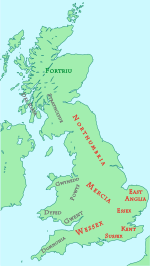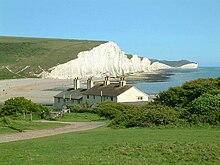Welcome to Visit Sussex Places
The Walkfo guide to things to do & explore in Sussex
![]() Visit Sussex places using Walkfo for free guided tours of the best Sussex places to visit. A unique way to experience Sussex’s places, Walkfo allows you to explore Sussex as you would a museum or art gallery with audio guides.
Visit Sussex places using Walkfo for free guided tours of the best Sussex places to visit. A unique way to experience Sussex’s places, Walkfo allows you to explore Sussex as you would a museum or art gallery with audio guides.
Visiting Sussex Walkfo Preview
Sussex is a historic county in South East England that was formerly an independent medieval Anglo-Saxon kingdom. It is bounded to the west by Hampshire, north by Surrey, northeast by Kent and south by the English Channel. Sussex was home to some of Europe’s earliest known hominids (Homo heidelbergensis), whose remains at Boxgrove have been dated to 500,000 years ago. Sussex played a key role in the Roman conquest of Britain when William, Duke of Normandy, landed at Pevensey and fought the decisive Battle of Hastings. When you visit Sussex, Walkfo brings Sussex places to life as you travel by foot, bike, bus or car with a mobile phone & headphones.
Sussex Places Overview: History, Culture & Facts about Sussex
Visit Sussex – Walkfo’s stats for the places to visit
With 14 audio plaques & Sussex places for you to explore in the Sussex area, Walkfo is the world’s largest heritage & history digital plaque provider. The AI continually learns & refines facts about the best Sussex places to visit from travel & tourism authorities (like Wikipedia), converting history into an interactive audio experience.
Sussex history
Beginnings
Boxgrove Man or Homo heidelbergensis is the earliest hominid remains in Europe dating back 500,000 years. The thriving population lived by hunting game such as horses, bison, mammoth and woolly rhinos. Sussex is rich in Bronze Age barrows known as the Devil’s Jumps and Cissbury Ring, one of Britain’s largest hillforts.
Roman canton

Much of Sussex was a Roman canton of the Regni, probably taking a similar area to the pre-Roman tribal area and kingdom. The Romans were called to restore the refugee Verica, a king whose capital was in the Selsey and Chichester area. Sussex was home to the magnificent Roman Palace at Fishbourne, by far the largest Roman residence known north of the Alps.
Saxon kingdom

The foundation legend of Sussex is provided by the Anglo-Saxon Chronicle. It seems Ælle secured the area between the Ouse and Cuckmere in a treaty. By the 7th century at the latest the South Saxon kings were ruling from sites around Selsey, the pre-Roman capital of the area.
Norman Sussex

Battle of Hastings was fought in Sussex, the victory that led to the Norman conquest of England. William of Normandy landed with his forces at Pevensey and erected a wooden castle at Hastings, from which they raided the surrounding area. Sussex experienced some of the greatest changes of any English county under the Normans.
Sussex under the Plantagenets
Sussex Downs were the location of the Battle of Lewes in 1264, in which Simon de Montfort and his fellow barons captured Prince Edward (later Edward I), the son and heir of Henry III. Sussex found itself on the frontline during the Hundred Years’ War. Hastings, Rye and Winchelsea were all burnt during this period and all three towns became part of the Cinque Ports, a loose federation for supplying ships for the country’s security.
Early modern Sussex
The Wealden iron industry expanded rapidly, especially after the first blast furnace arrived in Sussex 1496, from the Low Countries. Skilled Flemish workers moved to Sussex, followed again by Huguenot craftsmen from France, who brought new techniques. Under Elizabeth I, religious intolerance continued albeit on a lesser scale, with several people being executed for their Catholic beliefs.
Late modern and contemporary Sussex
Sussex had the highest poor law rates in England, with 37,000 people living on the breadline. Sussex became a centre for radicalism, with Thomas Paine developing his political ideas in Lewes. During World War I, the Royal Sussex Regiment took part in the Battle of the Boar’s Head at Richebourg-l’Avoué.
Sussex culture & places
Sussex is known for its strong tradition of bonfire celebrations and its proud musical heritage. The county is home to the Brighton Festival and the Brighton Fringe, England’s largest arts festival. Sussex in the first half of the 20th century was a major centre for modernism, and saw many radical artists and writers move to the county.
Architecture
Sussex’s building materials reflect its geology, being made of flint on and near the South Downs and sandstone in the Weald. The architecture of Sussex also has elaborate and eccentric buildings rarely matched elsewhere in England.
Dialect
Historically, Sussex has had its own dialect with regional differences reflecting its cultural history. It has been divided into variants for the three rapes of West Sussex, the two eastern rapes of Lewes and Pevensey and an area approximate to the easternmost rape of Hastings. Sussex dialect is also notable in having an unusually large number of words for mud.
Literature
Notable Sussex poets include William Collins, William Hayley, Percy Bysshe Shelley, Richard Realf, Wilfrid Scawen Blunt, Edward Carpenter and John Scott. Other writers from Sussex include Sheila Kaye-Smith, Noel Streatfeild, Patrick Hamilton, Rumer Godden and Hammond Innes.
Music
Sussex’s rich musical heritage encompasses folk, classical and popular genres. Many of the county’s traditional songs may not have changed significantly for centuries, with their origins perhaps dating as far back as the time of the South Saxons. Many composers of classical music including Thomas Weelkes, John Ireland, Edward Elgar, Frank Bridge, Sir Hubert Parry and Ralph Vaughan Williams recorded Sussex’s traditional music.
Religion
Christianity is the predominant religion in Sussex with 57.8 per cent of the population identifying as Christian. Other results from the 2011 census are: 1.4 per cent as Muslim, 0.7 per cent Hindu and 30.5 per cent having no religion. Sussex has been a single diocese of established church since the eighth century.
Science
Sussex was home to the Isaac Newton Telescope at the Royal Greenwich Observatory in Herstmonceux Castle. Gideon Mantell began the scientific study of dinosaurs in the 19th century. John Maynard Keynes was the founding father of Keynesian economics and the most influential economist of the 20th century.
Sport
Sussex has played a key role in the early development of cricket and stoolball. Founded in 1839, Sussex CCC is England’s oldest county cricket club. The Sussex Cricket League is believed to be the largest adult cricket league in the world with 335 teams in 2018.
Cuisine

Pulborough eel, Selsey cockle, Chichester lobster, Rye herring, Arundel mullet, Amberley trout and Bourne wheatear. Sussex is also known for its cakes and biscuits known as Sussex Plum Heavies and Sussex Lardy Johns. The county has vineyards and a long history of brewing of beer.
Visual arts

Some of the earliest known art in Sussex is the carvings in the galleries of the Neolithic flint mines at Cissbury on the South Downs near Worthing. From the Roman period, the palace at Fishbourne has the largest in situ collection of mosaics in the UK. The Long Man of Wilmington is Europe’s largest representation of the human form.
Sussex toponymy
The name “Sussex” is derived from the Middle English Suth-sæxe. The South Saxons were a Germanic tribe that settled in the region from the North German Plain during the 5th and 6th centuries. Three U.S. counties (in Delaware, New Jersey, and Virginia), and a former county/land division of Western Australia, are named after Sussex.
Sussex geography / climate
Landscape

The physical geography of Sussex relies heavily on its lying on the southern part of the Wealden anticline. At 280 m (918 ft) Blackdown is the highest point in Sussex, or county top. The River Medway is the longest river flowing through Sussex.
Climate
Most of Sussex lies in hardiness zone 8; the exception is the coastal plain west of Brighton. Rainfall is below average with the heaviest precipitation on the South Downs with 950 mm (37 in) of rainfall per year. The close proximity of Sussex to the Continent of Europe results in cold spells in winter and hot, humid weather in summer.
Conurbations
Brighton/Worthing/Littlehampton conurbation is home to almost 1 in 3 of Sussex’s population. Most of the population is distributed in an east-west line along the English Channel coast or on the east-east line of the A272. The exception to this pattern is the 20th century north-south development on the A23-Brighton line corridor.
Why visit Sussex with Walkfo Travel Guide App?
![]() You can visit Sussex places with Walkfo Sussex to hear history at Sussex’s places whilst walking around using the free digital tour app. Walkfo Sussex has 14 places to visit in our interactive Sussex map, with amazing history, culture & travel facts you can explore the same way you would at a museum or art gallery with information audio headset. With Walkfo, you can travel by foot, bike or bus throughout Sussex, being in the moment, without digital distraction or limits to a specific walking route. Our historic audio walks, National Trust interactive audio experiences, digital tour guides for English Heritage locations are available at Sussex places, with a AI tour guide to help you get the best from a visit to Sussex & the surrounding areas.
You can visit Sussex places with Walkfo Sussex to hear history at Sussex’s places whilst walking around using the free digital tour app. Walkfo Sussex has 14 places to visit in our interactive Sussex map, with amazing history, culture & travel facts you can explore the same way you would at a museum or art gallery with information audio headset. With Walkfo, you can travel by foot, bike or bus throughout Sussex, being in the moment, without digital distraction or limits to a specific walking route. Our historic audio walks, National Trust interactive audio experiences, digital tour guides for English Heritage locations are available at Sussex places, with a AI tour guide to help you get the best from a visit to Sussex & the surrounding areas.
“Curated content for millions of locations across the UK, with 14 audio facts unique to Sussex places in an interactive Sussex map you can explore.”
Walkfo: Visit Sussex Places Map
14 tourist, history, culture & geography spots
Sussex historic spots | Sussex tourist destinations | Sussex plaques | Sussex geographic features |
| Walkfo Sussex tourism map key: places to see & visit like National Trust sites, Blue Plaques, English Heritage locations & top tourist destinations in Sussex | |||
Best Sussex places to visit
Sussex has places to explore by foot, bike or bus. Below are a selection of the varied Sussex’s destinations you can visit with additional content available at the Walkfo Sussex’s information audio spots:
 | Sheffield Park Garden Sheffield Park Garden is an informal landscape garden five miles east of Haywards Heath, East Sussex. It was laid out in the 18th century by Capability Brown and further developed in the early 20th century. It is now owned by the National Trust. |
Visit Sussex plaques
![]() 1
1
plaques
here Sussex has 1 physical plaques in tourist plaque schemes for you to explore via Walkfo Sussex plaques audio map when visiting. Plaques like National Heritage’s “Blue Plaques” provide visual geo-markers to highlight points-of-interest at the places where they happened – and Walkfo’s AI has researched additional, deeper content when you visit Sussex using the app. Experience the history of a location when Walkfo local tourist guide app triggers audio close to each Sussex plaque. Explore Plaques & History has a complete list of Hartlepool’s plaques & Hartlepool history plaque map.